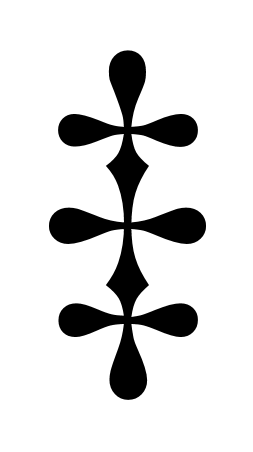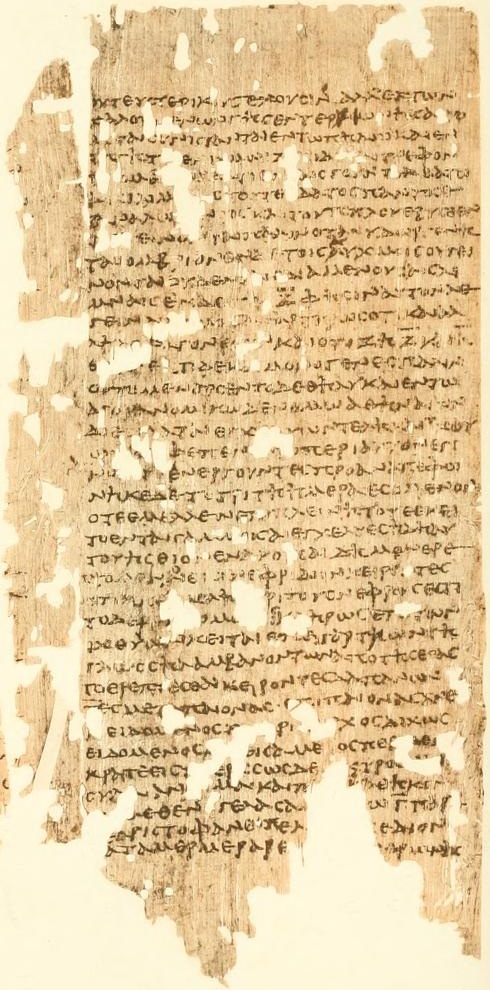|
Obelus
An obelus (plural: obeluses or obeli) is a term in codicology and latterly in typography that refers to a historical annotation mark which has resolved to three modern meanings: * Division sign * Dagger * Commercial minus sign (limited geographical area of use) The word "obelus" comes from (obelós), the Ancient Greek word for a sharpened stick, spit, or pointed pillar. This is the same root as that of the word ' obelisk'. In mathematics, the first symbol is mainly used in Anglophone countries to represent the mathematical operation of division and is called an obelus. In editing texts, the second symbol, also called a dagger mark is used to indicate erroneous or dubious content; or as a reference mark or footnote indicator. It also has other uses in a variety of specialist contexts. Use in text annotation The modern dagger symbol originated from a variant of the obelus, originally depicted by a plain line , or a line with one or two dots . It represented an ... [...More Info...] [...Related Items...] OR: [Wikipedia] [Google] [Baidu] |
Dagger (mark)
A dagger, obelisk, or obelus is a typographical mark that usually indicates a footnote if an asterisk has already been used. The symbol is also used to indicate death (of people) or extinction (of species or languages). It is one of the modern descendants of the obelus, a mark used historically by scholars as a critical or highlighting indicator in manuscripts. In older texts, it is called an ''obelisk''. A double dagger, or diesis, is a variant with two hilts and crossguards that usually marks a third footnote after the asterisk and dagger. The triple dagger is a variant with three crossguards and is used by medievalists to indicate another level of notation. History The dagger symbol originated from a variant of the obelus, originally depicted by a plain line or a line with one or two dots . It represented an iron roasting spit, a dart, or the sharp end of a javelin, symbolizing the skewering or cutting out of dubious matter. The obelus is believed to have be ... [...More Info...] [...Related Items...] OR: [Wikipedia] [Google] [Baidu] |
Dagger (typography)
A dagger, obelisk, or obelus is a glyph, typographical mark that usually indicates a footnote if an asterisk has already been used. The symbol is also used to indicate death (of people) or extinction (of species or languages). It is one of the modern descendants of the obelus, a mark used historically by scholars as a critical or highlighting indicator in manuscripts. In older texts, it is called an ''obelisk''. A double dagger, or diesis, is a variant with two hilts and crossguards that usually marks a third footnote after the asterisk and dagger. The triple dagger is a variant with three crossguards and is used by Medieval studies, medievalists to indicate another level of notation. History The dagger symbol originated from a variant of the obelus, originally depicted by a plain line or a line with one or two dots . It represented an iron roasting spit, a dart, or the sharp end of a javelin, symbolizing the skewering or cutting out of dubious matter. The obelus is be ... [...More Info...] [...Related Items...] OR: [Wikipedia] [Google] [Baidu] |
Obelus Variants
An obelus (plural: obeluses or obeli) is a term in codicology and latterly in typography that refers to a historical annotation mark which has resolved to three modern meanings: * Division sign * Dagger * Commercial minus sign (limited geographical area of use) The word "obelus" comes from (obelós), the Ancient Greek word for a sharpened stick, spit, or pointed pillar. This is the same root as that of the word ' obelisk'. In mathematics, the first symbol is mainly used in Anglophone countries to represent the mathematical operation of division and is called an obelus. In editing texts, the second symbol, also called a dagger mark is used to indicate erroneous or dubious content; or as a reference mark or footnote indicator. It also has other uses in a variety of specialist contexts. Use in text annotation The modern dagger symbol originated from a variant of the obelus, originally depicted by a plain line , or a line with one or two dots . It represented an i ... [...More Info...] [...Related Items...] OR: [Wikipedia] [Google] [Baidu] |
Obelism
Obelism is the practice of annotating manuscripts with marks set in the margins. Modern obelisms are used by editors when proofreading a manuscript or typescript. Examples are "stet" (which is Latin for "Let it stand", used in this context to mean "disregard the previous mark") and " dele" (for "Delete"). The obelos symbol (see obelus) gets its name from the spit, or sharp end of a lance in ancient Greek. An obelos was placed by editors on the margins of manuscripts, especially in Homer, to indicate lines that may not have been written by Homer. The system was developed by Aristarchus and notably used later by Origen in his ''Hexapla''. Origen marked spurious words with an opening obelus and a closing metobelos ("end of obelus"). There were many other such shorthand symbols, to indicate corrections, emendations, deletions, additions, and so on. Most used are the editorial coronis, the paragraphos, the forked paragraphos, the reversed forked paragraphos, the hypodiastole, t ... [...More Info...] [...Related Items...] OR: [Wikipedia] [Google] [Baidu] |
Division (mathematics)
Division is one of the four basic operations of arithmetic. The other operations are addition, subtraction, and multiplication. What is being divided is called the ''dividend'', which is divided by the ''divisor'', and the result is called the ''quotient''. At an elementary level the division of two natural numbers is, among other Quotition and partition, possible interpretations, the process of calculating the number of times one number is contained within another. For example, if 20 apples are divided evenly between 4 people, everyone receives 5 apples (see picture). However, this number of times or the number contained (divisor) need not be integers. The division with remainder or Euclidean division of two natural numbers provides an integer ''quotient'', which is the number of times the second number is completely contained in the first number, and a ''remainder'', which is the part of the first number that remains, when in the course of computing the quotient, no further ... [...More Info...] [...Related Items...] OR: [Wikipedia] [Google] [Baidu] |
Division Sign
The division sign () is a mathematical symbol consisting of a short horizontal line with a dot above and another dot below, used in Anglophone countries to indicate the operation of division. This usage is not universal and the symbol has different meanings in other countries. Consequently, its use to denote division is deprecated in the ISO 80000-2 standard for notations used in mathematics, science and technology. In mathematics The obelus, a historical glyph consisting of a horizontal line with (or without) one or more dots, was first used as a symbol for division in 1659, in the algebra book ' by Johann Rahn, although previous writers had used the same symbol for subtraction. pp 270,271 Some near-contemporaries believed that John Pell, who edited the book, may have been responsible for this use of the symbol. Other symbols for division include the slash or solidus , the colon , and the fraction bar (the horizontal bar in a vertical fraction). The ISO 80000-2 st ... [...More Info...] [...Related Items...] OR: [Wikipedia] [Google] [Baidu] |
Johann Rahn
Johann Rahn (Latinised form Rhonius) (10 March 1622 – 25 May 1676) was a Swiss mathematician who is credited with the first use of the division sign, ÷ (a repurposed obelus An obelus (plural: obeluses or obeli) is a term in codicology and latterly in typography that refers to a historical annotation mark which has resolved to three modern meanings: * Division sign * Dagger * Commercial minus sign (limited g ... variant) and the therefore sign, ∴. The symbols were used in ''Teutsche Algebra'', published in 1659. John Pell collaborated with Rahn in this book, which contains an example of the Pell equation. It is uncertain whether Rahn or Pell was responsible for introducing the symbols. Books Teutsche Algebra- Johann H. Rahn Literature *R. Acampora ''Johann Heinrich Rahn und seine Teutsche Algebra'', in R. Gebhardt (Herausgeber) ''Visier- und Rechenbücher der frühen Neuzeit'', Schriften des Adam-Ries-Bundes Annaberg-Buchholz 19, 2008, S. 163–178 * Moritz ... [...More Info...] [...Related Items...] OR: [Wikipedia] [Google] [Baidu] |
Aristarchian Symbols
Aristarchian symbols are editorial marks developed during the Hellenistic period and the early Roman Empire for annotating then-ancient Greek texts—mainly the works of Homer. They were used to highlight missing text, text which was discrepant between sources, and text which appeared in the wrong place. Two main types of ancient Greek philological annotations can be distinguished: signs and explicit notes. Aristarchian symbols are signs. Early development The first philological sign () invented by Zenodotos of Ephesos, the first head of the Alexandrinian Library, in his edition of Homer was the (, a short horizontal dash ), which Zenodotos used to mark spurious lines. For this reason, the practice of using signs for textual criticism has been called obelism. Aristophanes of Byzantium later invented the asterisk () to mark lines that are duplicated from another place, as well as the lunate sigma () and the antisigma () for two consecutive and interchangeable lines of the ... [...More Info...] [...Related Items...] OR: [Wikipedia] [Google] [Baidu] |
Homeric Scholarship
Homeric scholarship is the study of any Homeric topic, especially the two large surviving Epic poetry, epics, the ''Iliad'' and ''Odyssey''. It is currently part of the academic discipline of classical studies. The subject is one of the oldest in education. Ancient scholarship Scholia Scholia are ancient commentaries, preserved in the margins of manuscripts. The term marginalia includes them. Some are Interlinear gloss, interlinear, written in very small characters. Over time the scholia were copied along with the work. When the copyist ran out of free text space, he listed them on separate pages or in separate works. The works of Homer have been heavily annotated since antiquity. The number of manuscripts of the ''Iliad'' is currently (2014) approximately 1800. The papyri of the ''Odyssey'' are less in number but are still in the order of dozens. The inventory is incomplete, and new finds continue to be made, but not all these texts contain scholia. No compendium has collated a ... [...More Info...] [...Related Items...] OR: [Wikipedia] [Google] [Baidu] |
Aristophanes Of Byzantium
__NOTOC__ Aristophanes of Byzantium ( ; Byzantium – Alexandria BC) was a Hellenistic Greek scholar, critic and grammarian, particularly renowned for his work in Homeric scholarship, but also for work on other classical authors such as Pindar and Hesiod. He soon moved to Alexandria and studied under Zenodotus, Callimachus, and Dionysius Iambus. He succeeded Eratosthenes as head librarian of the Library of Alexandria at the age of sixty. His students included Callistratus, Aristarchus of Samothrace, and perhaps Agallis. He was succeeded by Apollonius "The Classifier" (not to be confused with Apollonius of Rhodes, a previous head librarian of Alexandria). Aristophanes' pupil, Aristarchus of Samothrace, would be the sixth head librarian at the Library of Alexandria. Work Aristophanes was the first to deny that the " Precepts of Chiron" was the work of Hesiod. Inventions Accent system Aristophanes is credited with reducing the accents used in Greek to desi ... [...More Info...] [...Related Items...] OR: [Wikipedia] [Google] [Baidu] |



